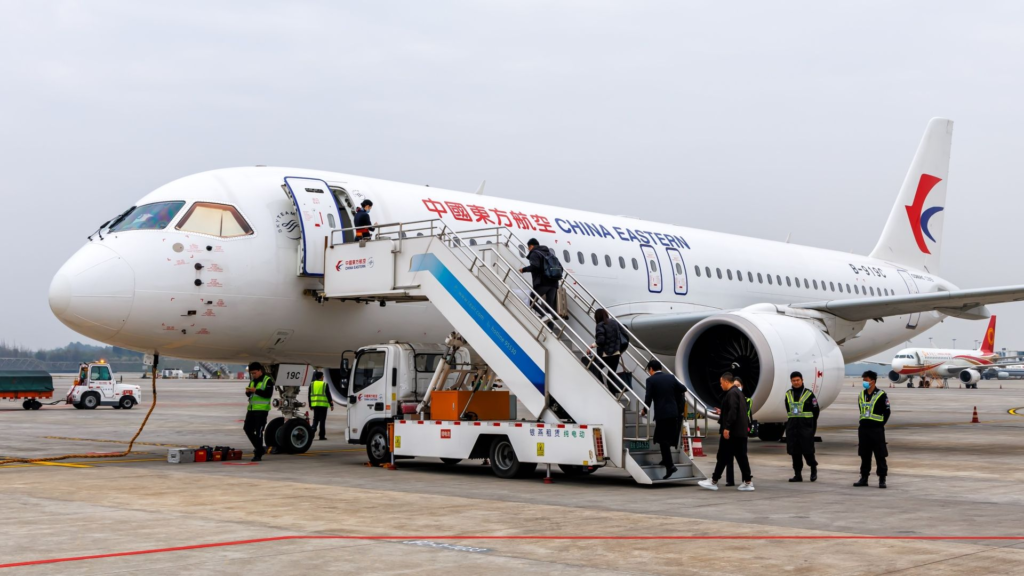Chinese planemaker Comac has reportedly had to revise delivery targets pertaining to its C919 family of narrowbody twinjet airliners due to the company falling behind on its projected production rates. Indeed, the firm is now only expecting to deliver around a third of the aircraft that it planned to roll out in 2025.
- Date Founded
-
May 11, 2008
- CEO
-
He Dongfeng
- Headquarters Location
-
Shanghai, China
- Business Type
-
Planemaker
The news comes as an unwelcome setback for the program, which is widely considered to be China’s best chance at penetrating the lucrative but exclusive narrowbody sector that is otherwise dominated by Airbus and Boeing. Thus far, the C919 has only seen domestic orders, but this may soon change.
Just 25 Deliveries Expected This Year
According to Bloomberg, COMAC entered the new year in good spirits, with an ambitious target of delivering 75 examples of its new C919 narrowbody twinjet airliner. This would have equated to approximately one every five days. Now, however, it has become clear that this goal is far from achievable.
Indeed, citing anonymous sources familiar with the matter, Bloomberg reported earlier today that the target has been slashed by two-thirds, with COMAC now only expecting 25 units of the C919 to have been delivered by the time that 2025 comes to an end. The move reportedly comes as the firm grapples with bottlenecks in its supply chain. Still, COMAC is proud of its narrowbody, with its website stating that:
“The C919 aircraft is the first jet-type trunk airliner independently developed by China in accordance with international airworthiness standards and owning independent intellectual property rights. The C919 has a layout of 158 to 192 seats, and a range of 4,075 to 5,555 kilometers.”
Various Challenges Have Hampered Production
![]() Air China, China Eastern Airlines, and China Southern Airlines are the three largest operators of the COMAC C919, which, as yet, has not been ordered by any foreign customers. According to recent reporting by Reuters, this trio of carriers alone was collectively expecting to receive 32 C919s in 2025.
Air China, China Eastern Airlines, and China Southern Airlines are the three largest operators of the COMAC C919, which, as yet, has not been ordered by any foreign customers. According to recent reporting by Reuters, this trio of carriers alone was collectively expecting to receive 32 C919s in 2025.
However, the reality on this front has been quite different, with just five examples having been transferred to these airlines this year as of September. COMAC’s annual goal of 75 examples of the C919 had originally been set back in March, when the total was raised from 50. However, since then, it has been forced to come to terms with a wide range of challenges that have severely restricted production rates.
A key factor on this front, as detailed in our coverage linked below, was the temporary ban on exports of the jet’s CFM engines, amid ongoing trade tensions between the US and China. While the situation was resolved over the summer, the damage had been done, highlighting the vulnerability of an aircraft reliant on foreign parts. Other US firms that supply parts for the jet include Honeywell and GE Aerospace.
The Current State Of The Operational COMAC C919 Fleet
According to present fleet data made available by ch-aviation, China Eastern Airlines is the largest operator of the COMAC C919, with 11 examples of the type at its disposal and a further 95 units on order. It is followed by Air China, with five jets and 100 orders, and China Southern Airlines, with five jets and 95 orders. Elsewhere, Suparna Airlines and Tibet Airlines respectively have two and 40 orders.
One of the program’s main struggles has been attracting foreign customers, with no airlines outside of China having formally put their name down for the type. That isn’t to say that the interest isn’t there, with Ryanair reportedly being open to the type, as covered in our video above. AirAsia is also in discussions.
As far as the current usage of the C919 is concerned, scheduling data from Cirium, an aviation analytics company, shows that 2,167 flights are scheduled with the type this month, offering 350,056 seats and 265,654,842 available seat miles. These services are split between 1,106 with China Eastern, 535 with China Southern, and 526 with Air China, with Hong Kong being the only destination outside the PRC.





